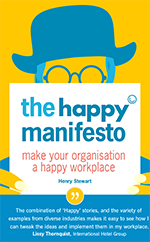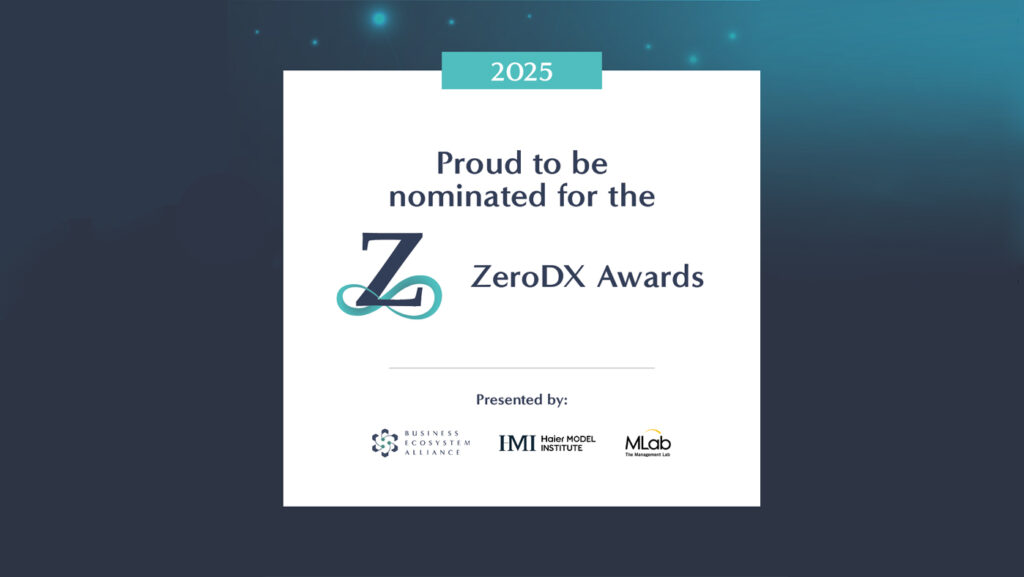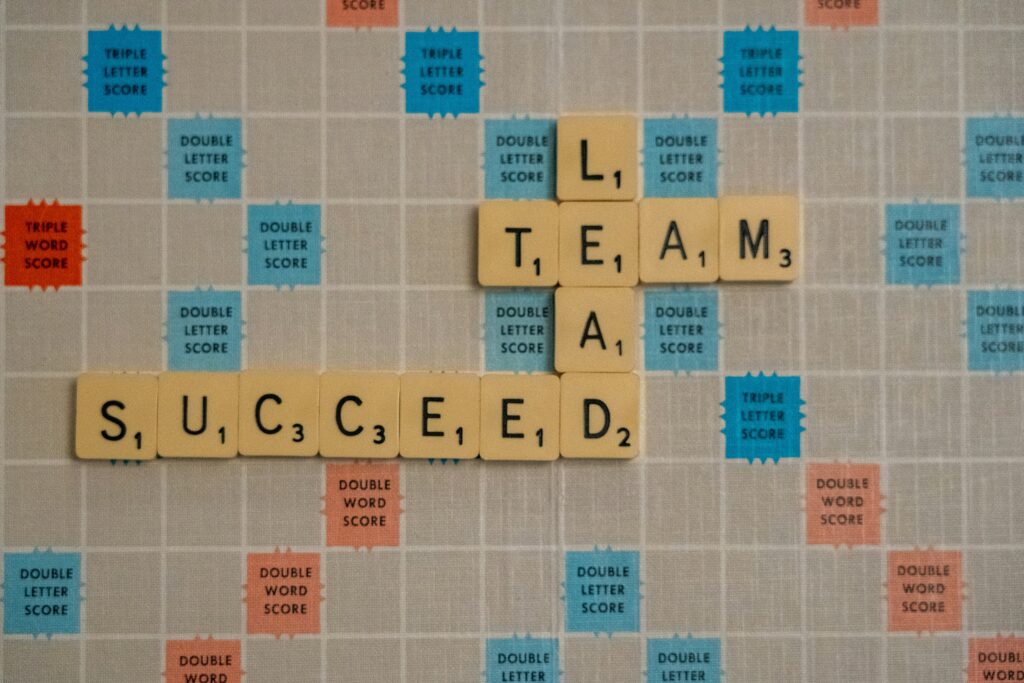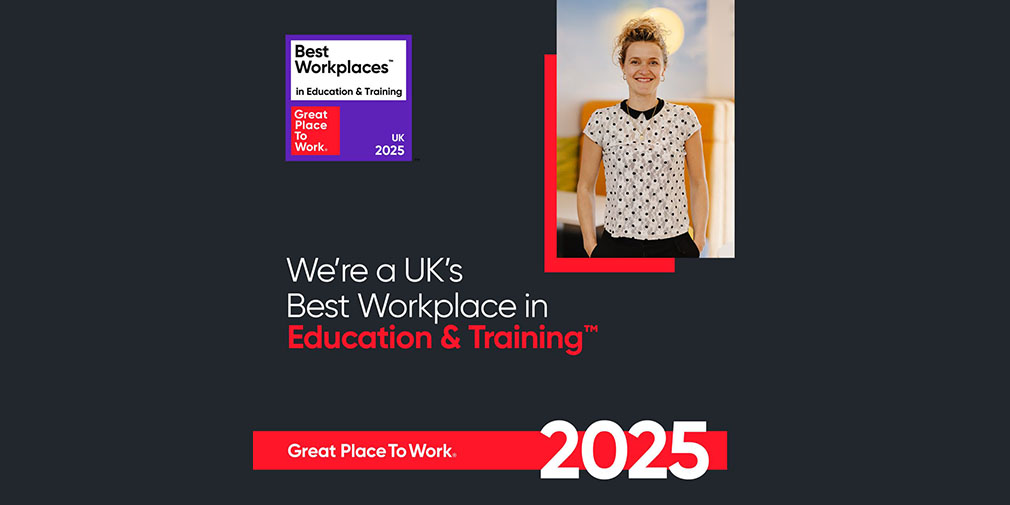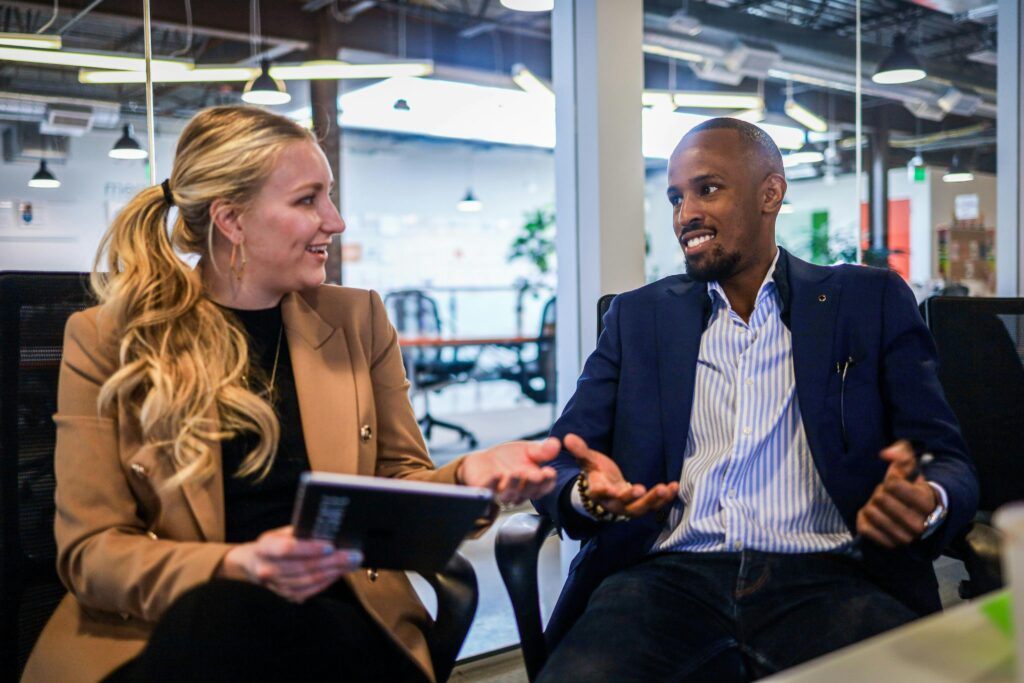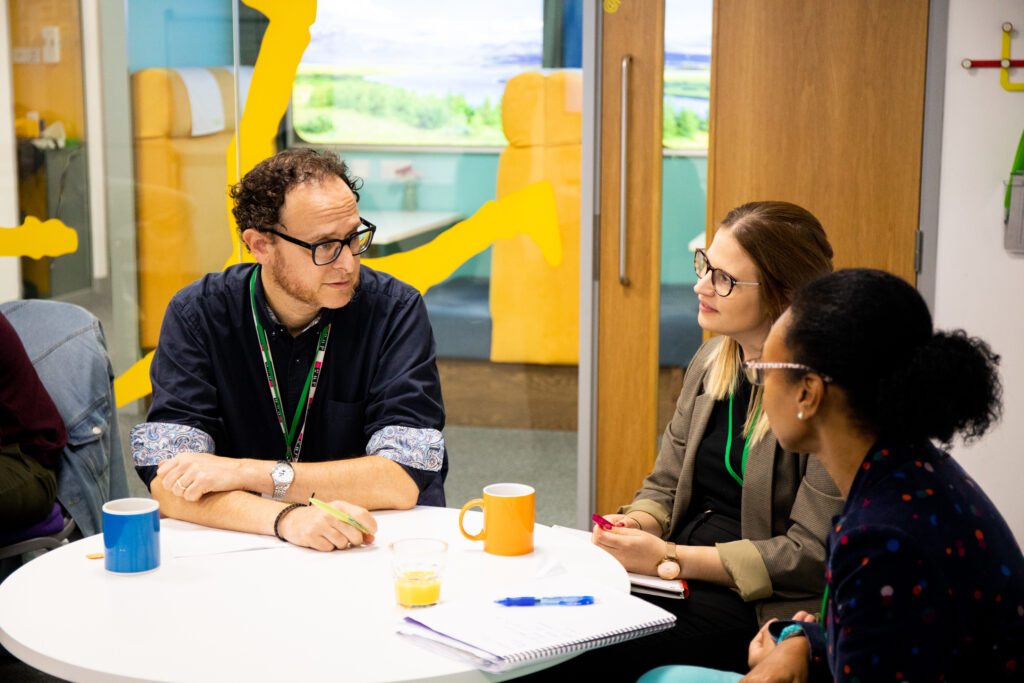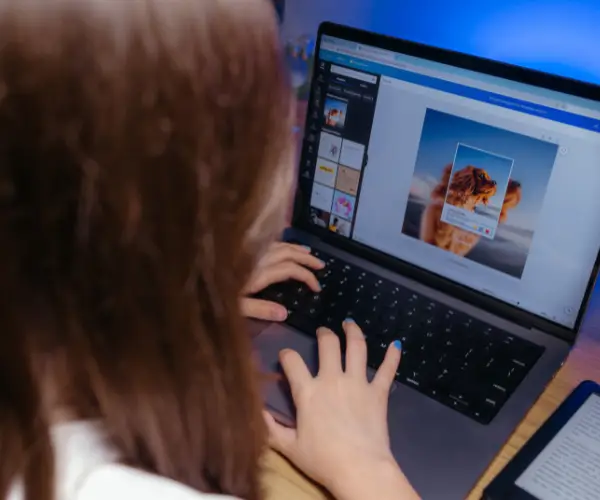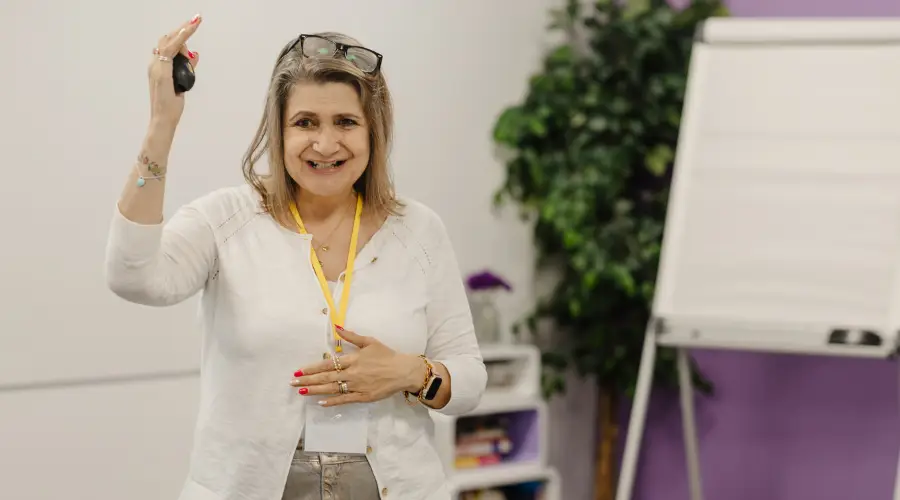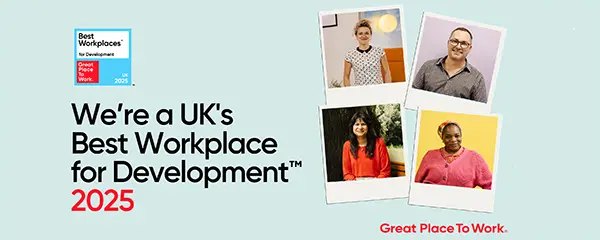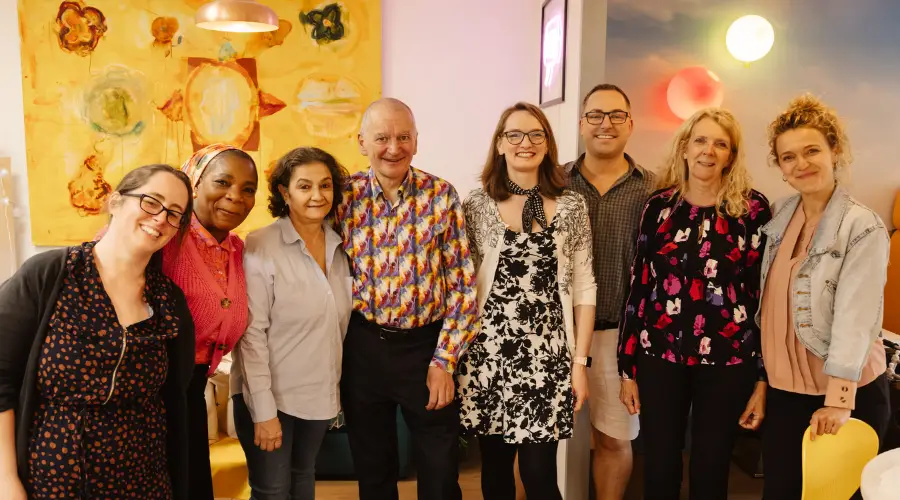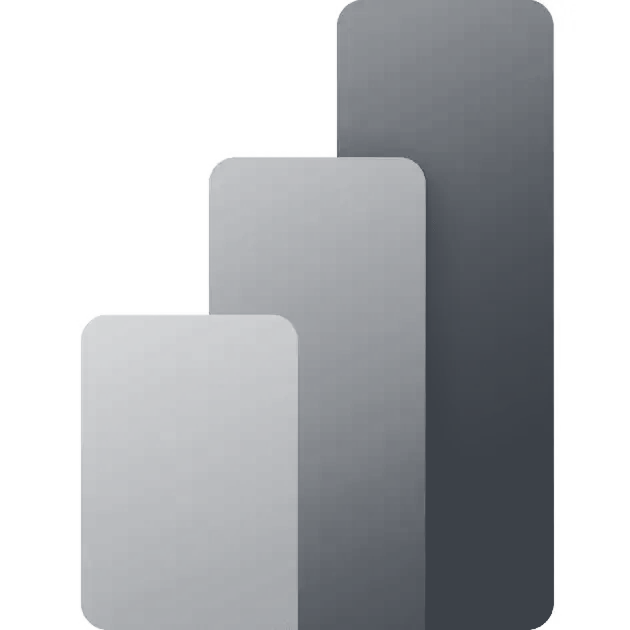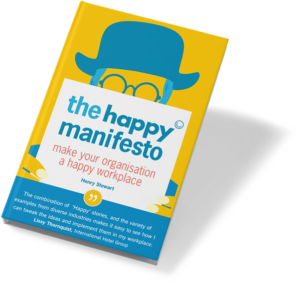One of the things that I was reflecting on this topic was actually how lucky and blessed I feel because I get to spend probably 95% of my time doing stuff every day that gives me joy. And at Happy, as a consultancy and training company, we work with lots of people where joy isn’t even on the radar, never mind the level that I experience. So I wanted to give us an opportunity to start to notice what are those things as well as some practical tips that you might want to take back and think about using to bring more joy.
So the first thing I’m going to ask you to think about is really simple: when have you been your most joyful at work. In pairs, whoever you’re sitting next to, have a discussion and think about that – when have you been your most joyful at work?
OK, let’s bring everyone back. One of the things I most love about asking a question like this is the moment you start to ask people about what brings them joy, they all start feeling more joyful. And that’s part of it, really – it’s about how much attention are we bringing to that day by day?
I’m just going to do a bit of a straw poll to get a sense of, in your own examples, whether some of these things were true, and I want to share a couple of examples from around the room.
So first of all, was it when you were paid a lot? Is that what gave you joy? OK, was it when you had a great manager? Yeah, that’s what we normally see, a couple of little hesitant hands: ‘maybe…?’
Was it when you felt trusted and challenged? Yeah, definitely, there’s often lots of that going on. And was it when you got to do what you’re best at and when you felt you made a difference? Yeah, perfect, and that’s really what it’s about.
So if we look at the pursuit of joy at work it’s often about looking at what am I really good at and how do I make sure I get to do as much of that everyday? It’s about playing to our strengths and that’s going to be one of the main topics of the session I’m going to lead you through.
There’s lots of talk about, ‘let’s talk smarter not harder,’ and actually working smarter isn’t about clever time management tips. It’s actually much more about finding out what you’re good at and getting a chance to do that. So that’s where we’re going to head with this.
So one of the stories I thought I’d just share with you is that recently I was doing some training and somebody said to me, ‘Oh there was a message from one of my colleagues that you’ve been working with over the last couple of years. You’ve been doing all sorts of training with them and they wanted me to tell you: “Thanks to you I’ve delivered a baby and resuscitated a 51-year-old.”
I was a bit [confused] and then I remembered this person. She works in a factory and in the time that I was working with her on leadership and development courses, one of the things that she was doing was studying to be a part time paramedic and it was so great to hear that story. So that’s one of my joyful moments, when somebody said to me, ‘You made a real difference, thank you for that.’ So let’s take that a little bit further and think about StrengthsFinder, and that’s one of the tools we use at Happy. I’ll introduce the book a little bit later.
It’s this great quote: ‘If you spend your life trying to be good at everything, you’ll never be great at anything.’ That’s really what we want to talk about here. So do you get to do what you’re best at every day, all day? Who would put their hand up to that one? So a few hands going up. I think it’s something we don’t really think about and it’s something we’ve been thinking about working towards for a really long time at Happy.
I mentioned I was at 95% for joyful work. It isn’t that everyday, all day. We’ve just introduced a new database system, which I have to be honest at times has brought my joy down to about minus 20. Anyone who’s introduced new technology will maybe be able to relate to that. But overall it’s that sense of I love what I get to do.
So let’s think about that further. So if I asked you the question, ‘How many people do you think get to do their best at work everyday?’ in fact the stats show it’s one in six. And if we think about limited resources and how we’re all really busy and how there’s lots going on, actually that’s a real lost opportunity. So this is that opportunity to think about how you might do more of that.
I’m just going to start by showing you a short video. This is a guy called Marcus Buckingham and he wrote the book, Now, Discover Your Strengths, which is how you have access to the StrengthsFinder tool, which allows you to identify your talents. And he’s just going to speak for a few minutes about strengths.
[Video audio]: ‘Because your strengths have certain, what? They have certain signs to them. Certain sort of tell tale signs, characteristics, and if you look back at your week – last week at work – and you try and look for those signs, you’ll be able to filter them out and I think be able to see from those signs what your true, most dominant, most powerful strengths are.
‘Here’s the first sign and it’s an obvious one, but pay attention to it. Your strengths have a yearning quality to them. They’re like a force inside you trying to get out. So watch to see which activities last week did you look forward to doing? Which activities did you find yourself volunteering for? There may not be that many of them because you did a lot of stuff last week, but see whether you can pull the curtain aside a wee bit and look for which were those activities you actually looked forward to doing.
‘Here’s a second sign. Your strengths are those things you’re naturally inquisitive about. Right? When you start doing an activity that’s around a strength of yours, you don’t struggle to concentrate, do you? Your mind doesn’t wander. You’re in the moment, you’re in the zone, you’re focused, you’re concentrated. Time just sort of zips by and you look up and a whole hour’s gone by. OK, what were those activities last week? Were there any? Any activities that you stay inquisitive around, that you keep learning around, that you keep researching around; those are all great signs of strengths.
‘And then last, your strengths have this restorative quality to them, don’t they? When you’re done with them, you may be physically tired, but you’re not psychologically drained, you’re not empty, you’re not depleted. You’re actually uplifted, you’re sustained, they fulfil you. That’s actually why you want to do them again, because you want that feeling again. OK look for those activities. Were there any activities last week that left you feeling kind of magnificent? What were they?
‘Look back for those three clues: which activities did you look forward to? Which activities did you stay inquisitive around and in the moment? And which activities left you feeling strong and magnificent? You see anything? Really, try it. Just look back – do you see anything emerging? Any activities, any patterns there last week where you can see some of those signs?
‘When I do that, three strengths come to the fore. First I interviewed a really good housekeeping supervisor. She’s got thirteen housekeepers she manages. She’s brilliant at it. I love doing that – interviewing anybody who’s really good at their job about why they’re good.
‘Second, I gave a presentation, one I’d prepared. I’m not good and I don’t like giving presentations. When I have them I need to know my stuff, get prepared. If I’ve done that I kind of like giving presentations.
‘And then third, I read an article and took notes on an article about the New Zealand rugby team. Which would you believe is and always been the best rugby team in the world. Which is kind of weird because there’s only three million people on those islands. There’s more sheep than New Zealanders and yet somehow they always wind up beating teams from countries ten times their size. I love doing that – interviewing, studying and reading up on organisational excellence. Particularly mysterious organisational excellence like that.
‘Picking out activities like that, for me, is really important work because those three activities – interviewing somebody who’s excellent at their job, giving a presentation when I’ve prepared, and researching organisational success – those three things are strengths of mine. Now, in saying that, I’m not saying I’m good at them. I’m not bad at them but I’m not great at them. I mean with each of them I have huge room to grow, huge improvement that’s got to be made in each one of those. All I’m saying is those three activities, those three very specific activities, make me feel strong. And that’s the best definition of a strength. For you as well as for me, for everybody, a strength is an activity that makes you feel strong.’
So, yes, let’s look at that then. So we’re going to get an opportunity to answer those three questions, so you can either do this in pairs or small groups. The first one is what activities did you look forward to doing last week? It’s that idea that they have a yearning quality to them, the things that you really eagerly anticipate when you’re thinking about your week ahead. Take a moment in small groups or pairs and discuss that question on your table.
I’m going to move on. The next question [is about] the things that make us naturally inquisitive. So where were you naturally inquisitive last week? Where were you in the moment? Was it in the same place where you were doing something that gave you joy? Or does something else come to mind? Explore it further.
So I’m going to pause you again for the third question that he asked, which was the restorative question, that idea that, even if at the end of the day you feel drained, it’s not in a way that’s depleting. And I know for myself if I’m facilitating events or working with people or just really supporting people in house, even if I’ve had a really busy day, at the end of it I often feel really uplifted. I feel inspired by the people I’ve worked with. So that’s his question: were there activities last week that left you feeling magnificent? And if so, what were they?
OK, I’m going to pause you there. I think the word magnificent itself is interesting. I was saying to a few of you I purposely did not water the word down. There was a moment where I corrected it to when you were left feeling good and I thought, you know what, I’m not going there – he said magnificent, we’re having magnificent on that slide!
I think the trouble is we often don’t think about work in those ways. So maybe some of your examples were more personal or you struggled a bit to find the example because the word is so strong and powerful. But that’s what it’s about. If we really want to pursue joy at work – and let’s be honest, we’re all spending a lot of time at work; why wouldn’t we want to be joyful there – we have to start thinking about, ‘what am I doing that helps me be at my best? What am I doing that stops that? And how do I change that and turn it around?’
So his lovely quote: ‘A strength is an activity that makes you feel strong.’ That’s something to really think about even if you struggled with that magnificent word. That’s the definition. So let’s share a couple of examples of things that we do at Happy.
The first question I want to ask generally is what could your team be like if everyone was working to their strengths and at their best? What would that be like? Who fancies answering that question for me?
Perfect – a happy and productive team. Who else wants to share what that would be like? Definitely, focused and driven. Energised – lovely word. It’s really interesting, as leaders we often want to set the vision, but actually when people are working to their strengths they’re energised to go in the direction you’re going in. You don’t have to drag them with you. Yes, absolutely, if we’re working to our strengths we’re doing what we are best at, we’re much more likely to be working smarter.
I don’t know about you, but when I’m working to my strengths it’s effortless. There’s always ways I can improve. Just like Marcus Buckingham said, there’s always things you can do better and make better, but actually it feels effortless, it looks easy. When you see somebody making something look easy, chances are they’re working to their strengths.
So one of the very first things that you can do is have that conversation with your team – what do you love to do? What gets you up in the morning? What helps you feel magnificent? So just starting by asking those questions can make a difference.
This is what we use. It’s the book that Marcus wrote and it gives you access to the online questionnaire. So basically for the cost of the book it allows you to do an online questionnaire, which identifies you to five talents. And the premise of the book is simply to find out what you’re good at and get even better at that and manage your weakness. There’s no good putting all your resource and training budgets and all those things that typically HR used to do into what you’re not good at, because at best you’ll only be mediocre at that.
So manage it, delegate it, find someone else to do it, someone who finds it easy and effortless and loves it. So that’s maybe about getting not so fixed on job descriptions. When somebody new starts at Happy one of the first things we get them to do is to fill in that questionnaire and then we look at the results and we work out what are the things that they’re good at? And what’s really great about this, the strengths are listed in a more generic way. So it’s not related to your industry or your sector or your organisation. It works for anyone.
I’ll give you an example. So one of my strengths as listed under the StrengthsFinder is something called Relater, which effectively means I love to build relationships and that works beautifully with my work internally at Happy, being responsible for the culture, but also externally working with lovely people like you. And I’m very pleased to say there’s many people in this audience that I’ve worked with for many years. So that’s a real strength of mine, something I love to do.
So that’s one easy way to just find out what people are good at. And also if you do that it gives you a common language. I think generally if I said to people in this room, ‘What’s a strength of yours?’ People would either not know or sort of waffle a bit. It’s not always easy to articulate it in a straightforward way.
One of the other things that we do is… this is an example of our organisation chart. You’ll see it’s not some pyramid of anything else. This was designed by Claire over here and Lydia; lovely Lydia and Claire. I set them a task and said, ‘I want an org chart that does not look like a normal org chart and it needs to have on it the information about what people are good at.’ So it lists the strengths of everybody. Also you’ll notice the colours and those are the colours of communication styles when people are relaxed and under pressure. That allows us to work out information about people in a really easy format.
So, for example, for me I’m green, which means – guess what – I’m a people person and when I’m under stress, I get even greener. So I want to work even more with people. I don’t want to be on my own. I want to be bouncing ideas off of others and that’s the example. So we get people to do communication styles, we get people to do the StrengthsFinder, we also get people to do a learning styles questionnaire, which looks at whether you’re an activist, reflector, theorist or pragmatist and that information is there as well. And it’s amazing how much you can capture in a really small space.
I’m just going to share a few ideas and then give you an opportunity if there’s anything that it sparks for you. One of the things we learn on our pursuit of joy at Happy is to watch your language. And one of the things we do on a monthly basis is we have a strategy group meeting, as I’m sure many of you do, and we report on our successes, opportunities, disappointments and threats. And we who are the leaders create a report about those things.
But if you look at the first letter of each of those, you’ll notice it was called the SODT report. My five per cent of joyless time at Happy often involved that blooming SODT report. As I was writing it and filling it in, I’d often be thinking, ‘sod it, sod it, sod it.’ It would drive me mad. And then something changed. One of our fabulous leaders who’s in charge of our apprenticeships scheme wrote something a bit different on theirs. They wrote this: ‘Ross previously worked night shifts in Poundland and has two young daughters. He always wanted a job where they could be proud of him.’
And that moved us and we thought that’s the sort of thing we want to be reporting on. Yes the numbers are important. Yes we’re a commercial business. But actually what really matters is the difference that we’re making to people, because that fits with our vision of we care. And it was that story that decided for us that we needed to change it.
And so, guess what, we still did numbers and successes, opportunities, yay let’s celebrate our learning, but what do you notice? What do those letters stand for? Joyful. So [for about a year and a half] we’ve now had the joyful strategy group meeting and the joyful report. We are reporting some stuff that’s the same as before, but the difference is we’re also trying to pull out the stories about the difference we make in people’s lives. And that makes a real difference to how we feel about what we do.
A couple of last things. Anyone still doing appraisals here? We scrapped ours last year, I’m afraid. We only do it when somebody’s new. So after their first three months we still do a typical appraisal, but we now have something different, which we call the Are You Happy At Happy? snapshot. It asks things like when did you get to work to your strengths? What have you done to help achieve unity and inclusiveness at Happy? What are you aspirations around our values? And we do this three times a year. It’s one sheet and the back of the sheet just has a reminder of our vision and mission and values and all of those things. So one side is information and one side is this, which people fill in.
We’ve always done regular one-to-ones, but that regular chance to pause and reflect and notice what we’re doing makes a massive difference. You’ll also notice the last question – what percentage of your role brings you joy and why? Don’t forget to measure the things that are important to you. It’s not some scientific thing, but [ask yourself] am I spending more time doing what I enjoy? That’s what it’s really about. Last time we did it we were at 73% across the business. My aim is to get everyone at 80%.
Interestingly enough, we had some people at 90 and some people at 20. Remember that database I talked about earlier? They were the ones a bit lower down, but we’re getting there on that one so our joy is definitely going up. So yes, we measure joy at work.
I just want to leave you with this quote: ‘You cannot be anything you want to be, but you can be a lot more of who you already are.’ Go play to your strengths, bring joy into the workplace, have lots of fun. Thank you
